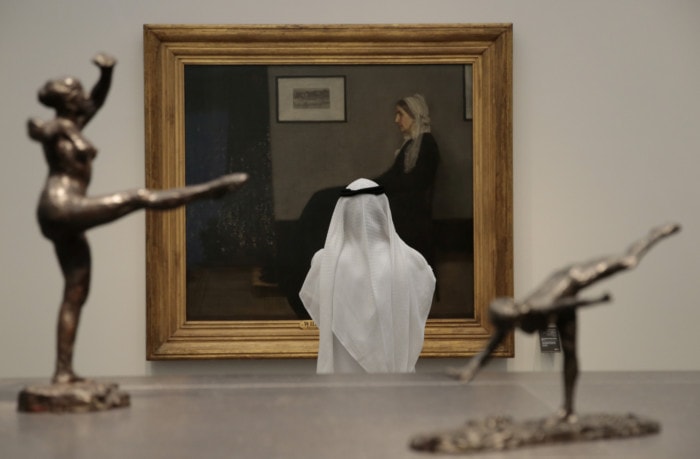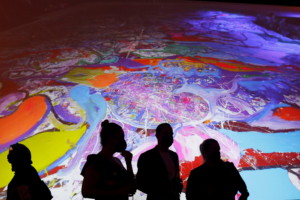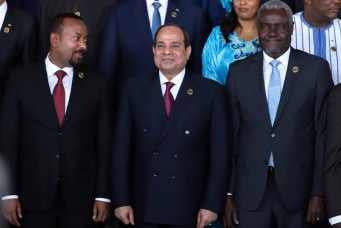The UAE Art Scene: Challenges and Opportunities
Sustainability and longevity of a thriving cultural sector in the Gulf must be treated as a priority, which is why long-term planning is essential in order to ensure the ability of the art field to meet with both current and future challenges.

The cultural scene in the United Arab Emirates (UAE) has witnessed a dramatic shift over the past few decades, marked by rapid development of art initiatives, institutions, auction houses, galleries, and creative hubs. The country’s annual art fair, biennale, and a number of large-scale international partnerships have also garnered it global recognition. However, amidst this very fast progress, an important question arises in regards to the art scene’s connection to local communities and audiences, and its critical acknowledgement and representation of earlier artistic histories within the Emirates and the region. Have some of these art initiatives developed in relative isolation from the public and bypassed their needs and realities, catering instead to a select smaller audience? It is also important to consider, in the context of these rapid and ongoing developments, the longer histories of artistic practices in the region and cultivate a study and recognition of possible continuities, rather than only focus on building anew. This presentation will question the trajectory of the UAE’s cultural development, and address possible tactics of making its art sector more accessible and inclusive.
The cultural landscape of the Arab Gulf States has undertaken a seismic shift over the past two decades. Countries that were erroneously regarded as cultural backwaters are now not only prime destinations for art and culture, but are also shaping the cultural scene in the wider region through their funding and acquisition programs. While Qatar, Bahrain and Kuwait have had notable successes with their national museums and exhibitions—and Saudi Arabia’s vision 2030 promises to reengineer the cultural scene of the region—it is perhaps the art scene of the United Arab Emirates that has overall made the most strident leaps from local to regional to global scales within one generation. The UAE’s unique federal political system has benefited the cultural scene, as individual semi-autonomous cities vie for cultural leadership status, in parallel with efforts by the federal Ministry of Culture to position the UAE as a leading country in that field.
The earliest iteration of a museum in what is present-day UAE, Al Ain Museum, was launched upon the initiative of the late Sheikh Zayed bin Sultan Al Nahyan (1919-2004) in 1969—predating the federal union by two years. The museum, established in the Abu Dhabi emirate, included notable gifts to the then ruler of Abu Dhabi as well as archeological finds in the emirate. It was, by any measure, a modest museum in size. Nevertheless, it constituted a considerable step forward, an indicator and a bellwether of bigger things to come. Almost 50 years later, the emirate—now capital of the UAE—inaugurated the Louvre Abu Dhabi.
In 1971, the year of the UAE’s federation, another entity of a similar nature opened in the country. The Dubai Museum, located in an 18th century fort, became the first to offer a look into the traditional way of life in the UAE as a museum experience. By the 1980s, a number of other major steps were taken, including the founding of the UAE’s Fine Arts Society in Sharjah in 1980, the Sharjah Art Biennale in 1993 and the Sharjah Art Museum in 1995. The 2000s were an especially busy time in the UAE as a number of art galleries opened along with the advent of auction houses and art collecting initiatives. Today, the UAE is arguably one of the region’s preeminent destinations for art and culture. However, as successful as the country has been over the past two decades, it has and continues to meet a number of challenges.
Challenges
Many commercial galleries in the UAE continue to face financial challenges as rising costs eat into their already tight profit margins. In fact, a number of art galleries had already shuttered, even before the global pandemic. The lack of rent control and varying government fees made financial planning a difficult task. For instance, Majlis Gallery, which opened its doors in 1989 and operated for over 30 years, had to close down in 2020. Salary costs, which are tied to the rising cost of living, and the dearth of corporate buyers also contribute to the difficulty of running gallery spaces in the country. Most UAE corporations, while benefiting from the country’s lack of tax burdens, are unwilling to invest in culture. The burden of responsibility has therefore largely fallen on state-related institutions and on a small number of private collectors. The stringent UAE import and export regulations also mean that loaning works to international institutions can become burdensome when exhibitions extend beyond the six-month window within which exported items can be shipped back into the country without incurring further import fees. Furthermore, tensions associated with the Arab Spring have reverberated across the region, and caused some countries to pause their investment in culture, while galleries, fairs and art exhibitions had to take down works that were now seen as excessively political. The same has occurred in the UAE over the past two decades with fairs taking down political works, although regulations are no longer as strict when it comes to the display of nudity.
The collapse of Abraaj and loss of collections
The 2018 collapse of the financial monolith Abraaj Capital, left a void in the UAE’s cultural economy that has yet to be filled. Abraaj was an unusual financial entity in that it was also a major art collector that funded an annual $100,000 art prize for an entire decade between 2008 and 2018. Additionally, its art collection was also noteworthy in that it concentrated on collecting art from the region rather than from global art producers. Abraaj was keen on investing in culture from what it touted as the MENASA region that spans from North Africa to South Asia. In 2018, only three months after the institution’s collapse, a significant part of its collection sold for $6.5 million at auction. Although the collection was auctioned publicly and is now scattered all over the world, the 29 commissioned works that were granted the Abraaj Group Art Prize between 2008 and 2018 were all acquired by Saudi Arabia’s Art Jameel, thereby remaining in a regional collection (by comparison, Deutsche Bank holds around 55,000 artworks in its collection).
The sale of the UAE Abraaj collection—partly through a public auction, and partly in a private sale to a Saudi entity—demonstrates the oversight on the part of the UAE corporate institutions to step in and take advantage of this rare opportunity to safeguard an important collection of art, and retain it in the country. This was not the only such instance. A few years earlier, for example, a major collector of South Asian art shipped their entire collection of 1,000 artworks from the UAE to the UK and, in September 2020, offered 80 of these works for sale through an auction. Today, there are two other major collections whose founders are seeking to sell them in a bulk sale, and whose export would surely be a loss to the UAE art sector at large. By contrast, it is worth noting that in 2002 Qatar acquired the entire collection of 400 Islamic art objects from the renowned Kuwaiti scholar and collector Jassim Yousef Al Homaizi (1939-2004) for $140 million. Al Homaizi was considered an important pillar of culture in Kuwait, and Al Qabas newspaper called the sale بالفعل خسارة ثقافية لا تقدر بثمن للكويت or “an actual priceless cultural loss for Kuwait.” Another example was Sheikh Hassan Al Thani’s donation in 2004 of a sizable part of his collection of modern Arab art, which he began in 1984, to what would later become the Mathaf: Arab Museum of Modern Art.
Geopolitics as a cultural barrier
As much as the UAE has benefited from its geographic location, both culturally and economically, recent geopolitical shifts have also palpably impacted the cultural scene, and not always in a positive way. For instance, as sanctions tightened on Iran over the past decade, less and less Iranians were able to travel to the UAE, and the shipment of art across the Gulf became both more challenging and expensive. The market of Iranian art, which included auctions such as Magic of Persia that were held periodically in Dubai, was negatively impacted as well. An example of the success of this market can be traced back to April 2008, when Iranian Parviz Tanavoli’s “The Wall (Oh Persepolis)” was auctioned in Dubai’s Emirates Towers with an estimate of USD 400,000 – USD 600,000, but was actually sold for USD 2,841,000—over 4.5 times higher than its top estimate. Other geopolitical factors affecting the cultural scene include the ongoing Syrian Civil War, the 2017-2021 Gulf Crisis, the underlying political tensions with Turkey, and the 2020 collapse of the currency and economy in Lebanon, historically an important conduit for art production that is ultimately sold in the UAE.
Embrace of Western art
While the UAE is geographically and culturally firmly situated in South West Asia, at the intersection of Africa, the Indian Ocean and the East Mediteranean in what is known as the Arabian Peninsula, the collecting practices of some of its major institutions continue to reflect the mindset of a traditional Western institution. Although data on the collecting practices of many of the UAE’s institutions is not easily available, surmising from public announcements of acquisitions, much of what is collected fits within the category of Western art. In one instance back in 2016, for example, I was asked by staff working for a major collecting museum in the region, to speak with their senior leader and explain to them the merits of—I am quoting here—“turn around his formula of two thirds Western art, to one third Eastern.” Other large museums continue to invest staggering figures into the purchase of European art, when equivalent funds could be used to establish entire collections of regional art—as proved by the sum values of all Middle Eastern works auctioned by both Sotheby’s and Christie’s in 2020. On one hand, the display of influential Western art in Eastern museums offers a valuable opportunity to those who are unable to travel to experience this art. On the other hand, however, this investment also comes at an opportunity cost of developing a more regional focus and a regional art collection.

Absent histories
Another opportunity often overlooked in the UAE art scene are exhibitions catering to the large South Asian community which constitutes around 60 percent of the country. Over the past two decades, the majority of the UAE’s exhibitions were geared towards either the Western or the Emirati community, oftentimes neglecting the country’s largest demographic. An notable exception to this oversight was Sharjah Art Museum’s exhibition Trajectories: 19th–21st Century Printmaking from India & Pakistan, held in September 2014, which was billed “first printmaking exhibition from the subcontinent to be held in the Middle East.” Curated by two South Asian scholars, Camilla H. Chaudhary and Dr Paula Sengupta, the exhibition presented a selection of 157 rare prints from the subcontinent. Furthermore, the exhibition went beyond the aesthetic, examining the era of British colonialism in printmaking styles as well as the era of independence and post independence. The importance of this exhibition is emphasized by the fact that curators were not able to meet in their respective countries due to visa restrictions resulting from tense political relations. Therefore, the UAE became a stage and platform for collaboration between these two strategically important regional countries. This mirrored a historic 1981 event, in which the UAE played host to a joint Indian-Pakistani cricket game that could not have been held in South Asia. Arguably, such exhibitions are more impactful and consequential than yet another display of Western art that can be seen elsewhere.
Major successes
An important milestone for the UAE came in March 2012 when the retrospective Ibrahim El-Salahi: A Visionary Modernist opened at the Sharjah Art Museum to celebrate the career of the acclaimed Sudanese artist. A Visionary Modernist was later shown at London’s Tate Modern, becoming the first exhibition conceived in a modern Arab art institution to travel to a Westrn art museum. Such initiatives allow the UAE to position itself on par with top global institutions, while delivering enriching content about the region’s art histories. They also enable us to “expand our understanding of modernity itself” in the words of Iranian scholar Shiva Balaghi in his article Iranian Visual Arts in ‘The Century of Machinery, Speed, and the Atom’: Rethinking Modernity. Another recent important development is the founding of the Arab Center for the Study of Art at NYU Abu Dhabi, which will finally offer an opportunity to study the regional art scene within a relevant context.
Culture as a Priority
In summary, the UAE art scene, although vibrant and pioneering in many of its initiatives, is in much need of reassessment in order to maintain its leading position in the region and beyond. Certain areas, such as legislation, audience awareness, and collecting strategies, would benefit from regular review and continuous adjustment, in order to meet with the ever-shifting regional and global circumstances. This must be spearheaded by both individuals, as well as organisations. The country’s Minister of Culture and Youth, for instance, has already started offering support to struggling galleries and artists, and launching initiatives to collect art. The UAE’s goals going forward should focus on encouraging corporate art collections, facilitating the remaining of important art collections, reducing fees and simplifying bureaucratic procedures. UAE cultural institutions should reconsider their exhibition programs, and make them relevant to a wider audience. Sustainability and longevity of a thriving cultural sector must be treated as a priority, which is why long-term planning is essential in order to ensure the ability of the art field to meet with both current and future challenges. With such adjustments, the UAE art scene can continue to be a leader not only in the region but also globally. Culture, after all, is the beacon of human intellectual achievement, and a means to better understand one another, and should therefore be prized at all levels.
Sultan Sooud Al Qassemi is an Emirati columnist and researcher on social, political and cultural affairs in the Arab Gulf States. He is also the founder of the Barjeel Art Foundation, an initiative that seeks to collect and promote modern art from the Arab world. He has taught the course “Politics of Modern Middle Eastern Art” at New York University, Yale University, Georgetown University, American University of Paris and is currently teaching the course at Boston College, US and SciencesPo, France.
Read More


